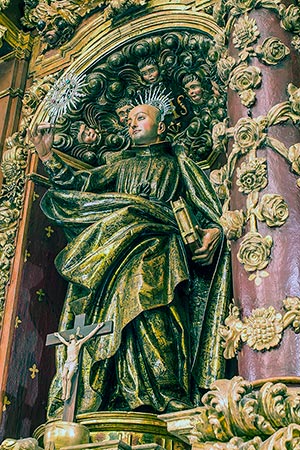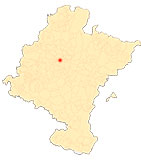Basilica of St. Ignatius of Loyola
By Ricardo Fernández Gracia
|
|
|
|
|
|
|
|
|
|
|
|
|
|
|
|
|
|
|
|
|
|
|
|
|
|
|
|
|
|
|
|
|
|
|
The titular image
The image that presides over the altarpiece does not correspond to the chronology of the latter, but is precisely a century earlier. It comes, like the one preserved in the cathedral of Pamplona, from the high school de la Anunciada of the Navarrese capital.
It was certainly taken to the basilica to preside over it together with the altarpiece of the aforementioned Jesuit high school , for the inauguration in 1694. That altarpiece -today in the parish of Azoz- made around 1632, contained an Ignatian cycle with four scenes that accompanied the sculpture. This was undoubtedly imported from workshops in Valladolid and is a copy of the image made by Gregorio Fernandez for the high school of Vergara in 1614. The high school from Pamplona brought several images from the Castilian capital in the 17th century, something that should not surprise us since, in Navarre, once the cycle of Romanism and its epigones was over, the plastic arts lacked quality and the good sets came from Madrid and Castile. Specifically, we know that the Inmaculada, which today presides over the entrance hall of the seminar in Pamplona, comes from the Jesuits and was brought from Valladolid in 1681, along with a head and hands for another vestment image, the Virgen del Buen committee, for the high school. With the same destination came from the Castilian capital a head and hands for the figure of St. Ignatius in 1675, and in 1672 several heads and hands of Jesuit saints for the procession that was organized on the occasion of the canonization of St. Francis Borgia.
The iconographic subject depends on the one that Gregorio Fernández made for Vergara in 1614, as has been pointed out, according to one of the models of great fortune created by the Valladolid sculptor. Regarding the repetition of the outline of his face, we must remember what Father Hornedo said, when he pointed out the existence of a mask of the saint in Valladolid, of which Francisco Pacheco himself gave an account. Naturally, the sculptor animated the shaved and dead face of the saint, representing him in full maturity, in a statue of medium height, holding with his right hand the IHS, magnet of his eyes to which he directs his gaze. The left forearm is not bent to hold a model, as it happens in other occasions, but it falls along the body carrying with the hand the book of the constitutions. Another characteristic of the sculpture, in tune with what the famous sculptor does with other saints, is to tertiary the mantle with bulging folds. The polychrome, fully baroque, is typical of the second third of the 17th century.
file Diocesan of Pamplona. Government of the Diocese. administrative office de Cámara. Boxes 293, 294, 295, 296 and 297.
ASCUNCE, E., Íñigo de Loyola, capitán español, y el castillo de Pamplona, Madrid, Aguado, 1939.
AZANZA LÓPEZ, J., La arquitectura religiosa del Barroco en Navarra, Pamplona, Government of Navarre, 1998.
EGUILLOR, J. R., Loyola, historia y arquitectura, San Sebastián, Etor, 1991.
FERNÁNDEZ GRACIA, R., El retablo barroco en Navarra, Pamplona, Government of Navarre, 2003.
FERNÁNDEZ GRACIA, R., "The Jesuits in Pamplona 1580-1767". Diario de Navarra, 28 April 2014, pp. 70-71.
FERNÁNDEZ GRACIA, R., "Heritage and identity (52). The basilica of San Ignacio in Pamplona". Diario de Navarra, 21 May 2021, pp. 62-63.
GARCÍA GAÍNZA, M.ª C. et al., Catalog Monumental de Navarra V. Merindad de Pamplona ***, Pamplona, Institución Príncipe de Viana, 1997.














